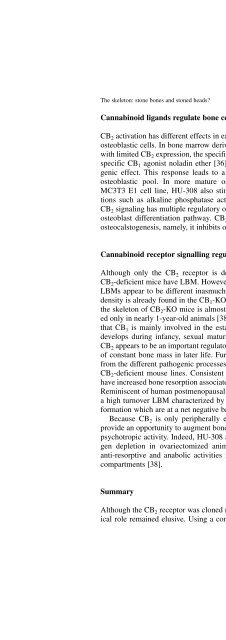3. Umbruch 4.4..2005 - Online Pot
3. Umbruch 4.4..2005 - Online Pot
3. Umbruch 4.4..2005 - Online Pot
Create successful ePaper yourself
Turn your PDF publications into a flip-book with our unique Google optimized e-Paper software.
The skeleton: stone bones and stoned heads? 203<br />
Cannabinoid ligands regulate bone cell differentiation and activity<br />
CB 2 activation has different effects in early preosteoblasts and in more mature<br />
osteoblastic cells. In bone marrow derived partially differentiated osteoblasts,<br />
with limited CB 2 expression, the specific CB 2 agonist HU-308 [35] but not the<br />
specific CB 1 agonist noladin ether [36], triggers a G i protein-mediated mitogenic<br />
effect. This response leads to a dose-response expansion of the preosteoblastic<br />
pool. In more mature osteoblastic cells, represented by the<br />
MC3T3 E1 cell line, HU-308 also stimulates osteoblast-differentiated functions<br />
such as alkaline phosphatase activity and matrix mineraliztion. Thus,<br />
CB 2 signaling has multiple regulatory osteogenic anabolic functions along the<br />
osteoblast differentiation pathway. CB 2 activation has an opposite effect on<br />
osteocalstogenesis, namely, it inhibits osteoclasts differentiation.<br />
Cannabinoid receptor signalling regulates bone mass in vivo<br />
Although only the CB 2 receptor is demonstrable in bone, both CB 1- and<br />
CB 2-deficient mice have LBM. However, the underlying mechanisms of these<br />
LBMs appear to be different inasmuch as a pronounced low trabecular bone<br />
density is already found in the CB 1-KO mice at a young age. At the same age<br />
the skeleton of CB 2-KO mice is almost normal, with severe bone loss reported<br />
only in nearly 1-year-old animals [38]. This age-related difference suggests<br />
that CB 1 is mainly involved in the establishment of peak bone mass, which<br />
develops during infancy, sexual maturation, and young adulthood [39, 40].<br />
CB 2 appears to be an important regulator of bone remodeling and maintenance<br />
of constant bone mass in later life. Further support for this notion is derived<br />
from the different pathogenic processes that lead to the LBM in the CB 1- and<br />
CB 2-deficient mouse lines. Consistent with their early LBM, CB 1-KO mice<br />
have increased bone resorption associated with decreased bone formation [38].<br />
Reminiscent of human postmenopausal osteoporosis [41], CB 2-KO mice have<br />
a high turnover LBM characterized by increases in both bone resorption and<br />
formation which are at a net negative balance [38].<br />
Because CB 2 is only peripherally expressed, CB 2-specific ligands could<br />
provide an opportunity to augment bone mass while avoiding the cannabinoid<br />
psychotropic activity. Indeed, HU-308 attenuates bone loss induced by estrogen<br />
depletion in ovariectomized animals with significant respective bone<br />
anti-resorptive and anabolic activities in the trabecular and cortical skeletal<br />
compartments [38].<br />
Summary<br />
Although the CB 2 receptor was cloned more than a decade ago, its physiological<br />
role remained elusive. Using a combined approach encompassing mole-







